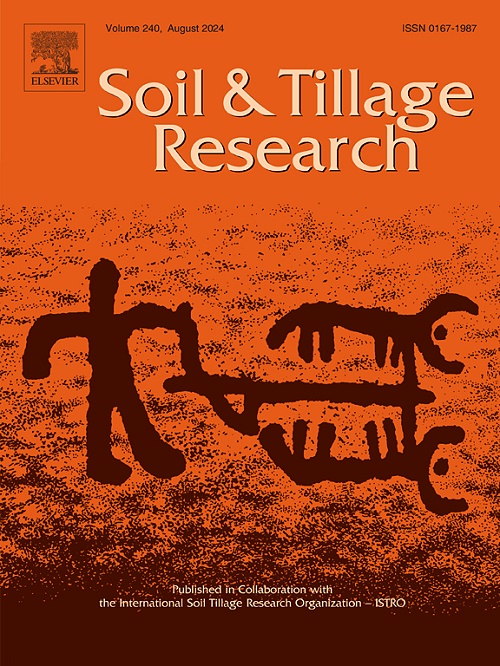Soil salinity accumulation and groundwater degradation due to overexploitation over recent 40-year period in Yaoba Oasis, China
IF 6.1
1区 农林科学
Q1 SOIL SCIENCE
引用次数: 0
Abstract
Yaoba Oasis is a traditional tillage farmland completely dependent on irrigation with groundwater. Previous investigations (1980–2015) have revealed that over-extraction of groundwater, deterioration of water quality, and soil salinization are the primary factors limiting the development of the regional agricultural economy. This study aimed to determine the impact of human activities, specifically groundwater exploitation and agricultural irrigation, on the migration of soil salinization since 1980 in the Yaoba Oasis. Specifically, water and soil samples were collected and analyzed from 90 wells and 21 soil sites. Results indicated that the groundwater level in the oasis has steadily declined at a rate of 0.04–0.59 m per year, primarily due to groundwater overexploitation. The annual average soil salt accumulation was approximately 91.1–155.2 mg/kg. Soil salinity was strongly correlated with the hydrochemical composition, with all indicators increasing along the flow path. Irrigation infiltration resulted in salt accumulation below 20 cm, with residual salts being leached by the irrigation return water. Overall, residual salt dissolution under flood irrigation and saltwater intrusion in desert salt lakes are the main reasons for soil salt accumulation and groundwater quality deterioration. To mitigate these issues and maintain the ecological balance of desert oases, it is imperative to limit the overexploitation of groundwater and reduce the amount of irrigation, thereby preventing groundwater contamination and soil salinization.
近40年窑坝绿洲过度开发导致的土壤盐分积累与地下水退化
窑坝绿洲是一个完全依靠地下水灌溉的传统耕作农田。前期调查(1980-2015)表明,地下水过度开采、水质恶化和土壤盐碱化是制约区域农业经济发展的主要因素。本研究旨在确定1980年以来人类活动,特别是地下水开采和农业灌溉对瑶坝绿洲土壤盐碱化迁移的影响。具体而言,从90口井和21个土壤点收集和分析了水和土壤样品。结果表明:绿洲地下水位以每年0.04 ~ 0.59 m的速率持续下降,主要原因是地下水过度开采。年平均土壤盐分积累量约为91.1 ~ 155.2 mg/kg。土壤盐分与水化学成分呈较强的相关关系,且各指标均沿流道增加。灌溉入渗导致盐分在20 cm以下积聚,剩余盐分被灌溉回灌水淋滤。总体而言,洪水灌溉下的残盐溶解和沙漠盐湖的盐水入侵是导致土壤盐分积累和地下水水质恶化的主要原因。为了缓解这些问题,保持沙漠绿洲的生态平衡,必须限制地下水的过度开采,减少灌溉,从而防止地下水污染和土壤盐渍化。
本文章由计算机程序翻译,如有差异,请以英文原文为准。
求助全文
约1分钟内获得全文
求助全文
来源期刊

Soil & Tillage Research
农林科学-土壤科学
CiteScore
13.00
自引率
6.20%
发文量
266
审稿时长
5 months
期刊介绍:
Soil & Tillage Research examines the physical, chemical and biological changes in the soil caused by tillage and field traffic. Manuscripts will be considered on aspects of soil science, physics, technology, mechanization and applied engineering for a sustainable balance among productivity, environmental quality and profitability. The following are examples of suitable topics within the scope of the journal of Soil and Tillage Research:
The agricultural and biosystems engineering associated with tillage (including no-tillage, reduced-tillage and direct drilling), irrigation and drainage, crops and crop rotations, fertilization, rehabilitation of mine spoils and processes used to modify soils. Soil change effects on establishment and yield of crops, growth of plants and roots, structure and erosion of soil, cycling of carbon and nutrients, greenhouse gas emissions, leaching, runoff and other processes that affect environmental quality. Characterization or modeling of tillage and field traffic responses, soil, climate, or topographic effects, soil deformation processes, tillage tools, traction devices, energy requirements, economics, surface and subsurface water quality effects, tillage effects on weed, pest and disease control, and their interactions.
 求助内容:
求助内容: 应助结果提醒方式:
应助结果提醒方式:


